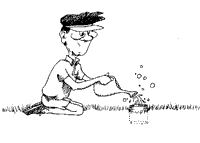How does the soil handle water?
Does The Soil Drain Well?
Normal, healthy soil manages to simultaneously drain well, yet retain moisture. It is able to do this only because its structure is loose--not compacted--and, because of its physical and chemical composition. So if your soil does not drain well after a rain or your watering, that suggests that it is not healthy. You may need to improve its structure and content. There are several ways to evaluate your soil's capacity to drain efficiently.
 Sunken Can Test - An easy test of drainage uses a large coffee can with the top and bottom cut out. Sink the coffee can down into the soil four or five inches. Then fill the can with water and determine how long it takes to drain. If it drains in less than an hour, you are in good shape. If it takes up to six hours, you are okay but could use some improvement. Anything over six hours suggests a fairly serious drainage problem.
Sunken Can Test - An easy test of drainage uses a large coffee can with the top and bottom cut out. Sink the coffee can down into the soil four or five inches. Then fill the can with water and determine how long it takes to drain. If it drains in less than an hour, you are in good shape. If it takes up to six hours, you are okay but could use some improvement. Anything over six hours suggests a fairly serious drainage problem.
Observe Puddles After A Rain - While puddles may indicate compacted soil, they also indicate drainage problems. Even compressed soil, if has certain physical and chemical properties will drain halfway decently. So the puddles may be signaling deficiencies in the composition of your soil.
Check Water Run-off - Like puddles, rivulets of water that run off the turf when it rains rather than soak into the soil, are suspicious. Water flowing off the lawn in streams similar to the flow of run-off down the driveway when it rains suggest that soil under your grass may be just as incapable of absorbing water as the paved drive! Obviously, this soil needs repair if it is to support healthy grass plants.
Evaluate Water Penetration
Examine a sample core of turf after a good rain. If your soil's drainage is satisfactory, the core should be moist all the way through its 4 to 6 inch depth. Another way to determine just how deeply an inch of rain has penetrated the soil is to use a houseplant water meter. Take it outside and insert the probe into the turf as you would into a container holding a plant. Do this at several spots over the lawn area. The meter will register the degree of moisture at each site. Where soil is dry, compaction may be the culprit.
Of course, some soils, by their very nature, are looser and more absorbent of moisture than others. In the next chapter, dealing with soil rehabilitation we will discuss the differences in sand, loam or clay based soils and how their respective structures can be improved to facilitate drainage.
Examine a sample core of turf after a good rain. If your soil's drainage is satisfactory, the core should be moist all the way through its 4 to 6 inch depth. Another way to determine just how deeply an inch of rain has penetrated the soil is to use a houseplant water meter. Take it outside and insert the probe into the turf as you would into a container holding a plant. Do this at several spots over the lawn area. The meter will register the degree of moisture at each site. Where soil is dry, compaction may be the culprit.
Of course, some soils, by their very nature, are looser and more absorbent of moisture than others. In the next chapter, dealing with soil rehabilitation we will discuss the differences in sand, loam or clay based soils and how their respective structures can be improved to facilitate drainage.
